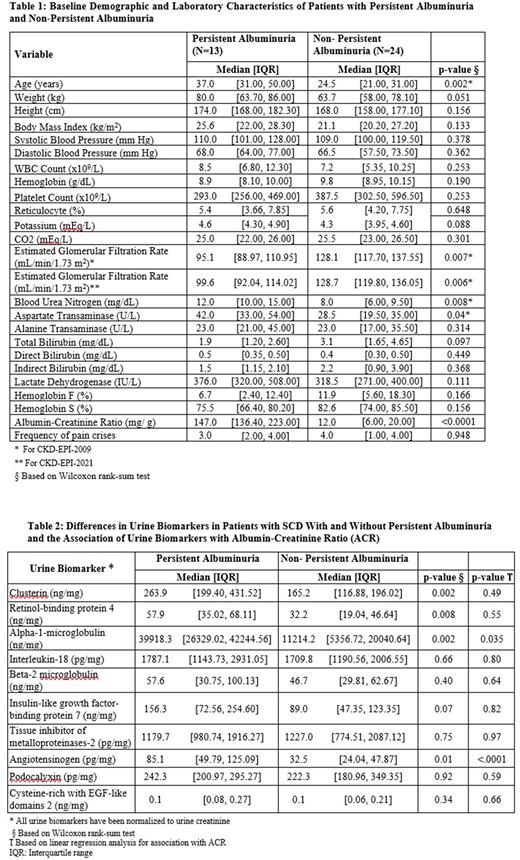Abstract
Introduction: Standard assessments for kidney disease, albuminuria and decline in estimated glomerular filtration rate (eGFR), occur well after substantial functional and structural damage have ensued. Chronic kidney disease (CKD) is common in patients with sickle cell disease (SCD). With its association with increased morbidity and mortality, identification of novel biomarkers that could predict early development of CKD offers opportunities to modify risk factors in hopes of attenuating kidney function loss and decreasing mortality risk.
Methods: The participants of this exploratory study represent a subset of patients with HbSS or HbSβ0 thalassemia enrolled in a prospective cohort study to assess the natural history of kidney disease in SCD. We excluded patients with diabetic nephropathy, cancer, connective tissue disease, other glomerular diseases, known infection with hepatitis (B or C) or HIV, end-stage kidney disease on dialysis and those who had undergone bone marrow transplantation. Participants were enrolled during routine clinic visits. Urine levels of clusterin [CLU; also referred to as apolipoprotein J], retinol-binding protein 4 [RBP4], alpha-1-microglobulin [A1M], interleukin-18 [IL-18], beta-2 microglobulin [B1M], insulin-like growth factor-binding protein 7 [IGFBP7], tissue inhibitor of metalloproteinases-2 [TIMP2], angiotensinogen [AGT], podocalyxin, and cysteine-rich with EGF-like domains 2 [CRELD2] were measured using quantitative ELISA assay. All values of urine biomarkers were normalized to urine creatinine. Persistent albuminuria (PA) was defined based on presence of at least 2 of 3 spot urine albumin/creatinine ratio (ACR) values ≥30 mg/g of creatinine or a single value ≥100 mg/g. Glomerular filtration rate was estimated using the 2009 creatinine-based Chronic Kidney Disease Epidemiology Collaboration (CKD-EPI) formula. Medians are presented with the interquartile range [IQR]. Associations between ACR and eGFR with each urine biomarker were assessed using linear regression. Levels of urinary biomarkers were compared using the Wilcoxon-Mann-Whitney test.
Results: Thirty-seven subjects, 13 (35.2%) with PA (ACR - 147mg/g [IQR: 136.4, 223]), and 24 (64.9%) without PA (non-PA) (ACR - 12 mg/g [IQR: [6, 20]) were evaluated. Subjects with PA were older, had higher blood urea nitrogen (BUN), blood aspartate transaminase, and lower eGFR (Table 1). Urinary levels of CLU, RBP4, A1M, and AGT normalized to urine creatinine were significantly higher in subjects with PA vs. those with non-PA (Table 2). In univariate analysis, significant associations were identified between A1M and ACR (p=0.035) as well as between AGT and ACR (p<0.0001) (Table 2). In multivariable analyses, only AGT remained significantly associated with ACR (p=0.0003).
Conclusion: The higher urinary levels of RBP4 and A1M, both low molecular weight proteins freely filtered in the glomerulus and reabsorbed by kidney proximal tubule cells, in subjects with PA suggests the presence of tubular injury. Higher levels of clusterin, a ubiquitously expressed glycoprotein that is rapidly upregulated upon acute kidney damage and present in de-differentiated kidney tubule cells, also indicates tubular injury in subjects with PA. Urinary AGT, the only precursor of all angiotensin peptides, is independently associated with ACR in this cohort. Higher levels of AGT indicates increased intrarenal renin-angiotensin system activity in subjects with PA. More studies are required to evaluate the association of these biomarkers with persistent albuminuria in SCD.
Disclosures
Ataga:Pfizer: Consultancy; Agios Pharmaceuticals: Consultancy; Roche: Consultancy; Biomarin: Consultancy; Forma Therapeutics: Consultancy, Honoraria, Membership on an entity's Board of Directors or advisory committees, Research Funding.
Author notes
Asterisk with author names denotes non-ASH members.


